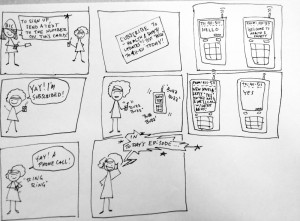It is difficult to imagine a more diverse group than ours. Law, design, community organizing, development, storytelling… Our large team gathers all expertises! As my colleague Christian said in a previous post, we do not have one partner. We have four: Brazilian Immigrant Center, REV-, The NuLawLab at Northeastern University, and TerraVoz.
Naturally, it is awesome to count on such a rich set of skills. Nevertheless, it is an enormous challenge to coordinate all efforts. I am sure Marisa feels sometimes that she is herding cats. So far, I tell you, she has been successful!
Our project proposal has also helped us to figure out our roles in this project. On Saturday, we received useful advice from Sasha/Codesign team to improve our proposal. One of the suggestions was to assign more specific tasks to each member. Thus, we can have a clearer idea of everybody’s responsibilities. An ongoing updated version of our project proposal can be found here:
https://docs.google.com/document/d/1VlispRgeNGESqzbXjL8ZKjjKr32oMi3CMM3rlDwZO6s/edit#
Another advice was the need of bringing all community partners together to discuss the design of our hotline. In fact, we have been talking a lot about this topic in our meetings. This drawing (by Marisa), for instance, illustrates the concept of “audio postcard” that we invented and that will be used in our project:
We also got inspiration from New Day New Standard Logic Tree:
We already have a rough draft of our voice tree:
https://docs.google.com/presentation/d/1xpXNy5MA1s4su7pMO8gUB50BI8hfbXYTh9XB1f5qSl4/edit
It is one of the outcomes from our first project iteration. However, we know that it is not good yet. We need more meetings with our community partners to discuss it (and improve it).
Another outcome from this first iteration was a group of characters and stories that are going to be used to convey our messages on safety and environmental issues to housecleaners. Marisa and Anjum organized an amazing collaborative storytelling session! First, we had to invent characters for the stories. The idea was: the funnier, the better. We drew our ideas and presented them to the group. After that, we began to create stories… with the characters that other members of the group invented. At first, such approach seemed a bit chaotic… but after some time the convergence of ideas was astonishing!
Finally, we started a research on safety, health, historical and legal issues related to domestic house cleaners in Massachusetts and elsewhere. That research inspired many discussions in our meetings and will provide the theoretical background for the messages we are going to convey.


Hey BIC Team!
Here’s some feedback on your latest blog post and draft proposal from Oct 14. I’m sharing feedback based on the Urbano methodology below. Let me know if I can clarify anything for you.
Cheers,
Bex
Clarify
– Clarify which parts of this proposal you will pursue for this class.
– Clarify how the parts of your team will work together as language in the MOU. See other groups’ MOUs and the examples we shared for guidance.
Value
– All of your proposals demonstrate building on the prior work that REV- has done to date sharing info so that domestic workers are more aware of their new rights and employees also are aware of new laws to comply with.
Concern
– One issue REV- has reflected on regarding the Nanny Hotline first implemented in NYC, was the difficulty in spreading the word about the hotline. Can you explain a bit about the ways that people will be sharing this version of the hotline and how the in-person organizing strategy will include this channel of information?
Suggestions
– Include REV- and NuLawLab as partners listed in the “Partner Mission” area so we know more about the team and why people are participating.
hi BIC team!
Good job of getting more concrete about design. It’s good to see this storyboard and the sketch of your logic tree. One lesson from NDNS was that the voice tree was actually quite difficult to navigate. A way to really push yourselves beyond the model of NDNS and to think about a tree that serves your callers as well as possible would be to draw a few more voice trees. If you try to draw 3 wildly different versions, you’ll make yourselves think more creatively about how to solve the problem of moving between audio content in a streamlined way.
Cheers,
Bex